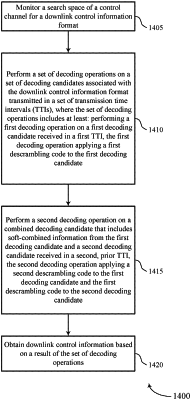| CPC H04W 72/23 (2023.01) [H04L 1/08 (2013.01); H04L 5/0053 (2013.01)] | 68 Claims |

|
1. A method for wireless communication at a user equipment (UE), comprising:
monitoring a search space of a control channel for a downlink control information format;
performing a plurality of decoding operations on a plurality of decoding candidates associated with the downlink control information format transmitted in a plurality of transmission time intervals (TTIs), wherein the plurality of decoding operations comprises at least:
performing a first decoding operation on a first decoding candidate received in a first TTI, the first decoding operation applying a first descrambling code to the first decoding candidate; and
performing a second decoding operation on a combined decoding candidate that comprises soft-combined information from the first decoding candidate and a second decoding candidate received in a second, prior TTI, the second decoding operation applying a second descrambling code to the first decoding candidate and the first descrambling code to the second decoding candidate; and
obtaining downlink control information based at least in part on a result of the plurality of decoding operations.
|